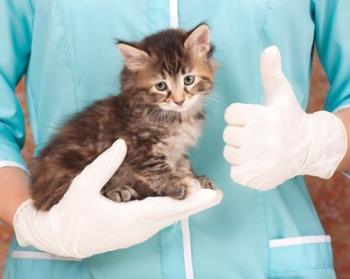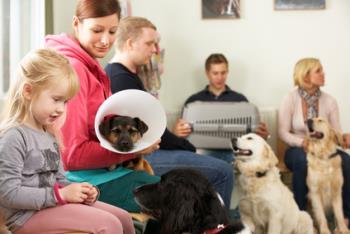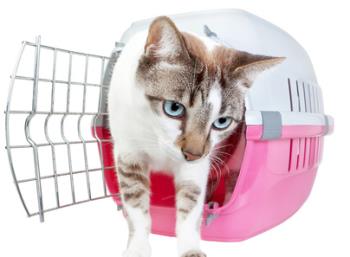 Is your cat stressed during a vet visit? Society thinks that vets are doing a favorable job (and they do), but cats actually don’t view it that way. There is a lot you can do at home to relieve your cat’s everyday stress, but it’s a whole different matter if you are taking your cat to the vet.
Is your cat stressed during a vet visit? Society thinks that vets are doing a favorable job (and they do), but cats actually don’t view it that way. There is a lot you can do at home to relieve your cat’s everyday stress, but it’s a whole different matter if you are taking your cat to the vet.
Luckily, there are several things that will help to make the next veterinary visit less stressful to your cat.
Make your cat love his carrier
Not all cats hate pet carriers, but many do. Why? Because they associate them with something negative, like visiting a veterinarian. There is a strong logic behind the reason why cats hate their carriers; however, there are also things to do to change that. And you should.
As your cat travels to a vet clinic, his relationship with the cat carrier is the most important factor in determining whether he will be stressed or relaxed. As a comparison, can you imagine yourself being a passenger in a drive to the woods at night? Would you rather travel there in a comfy limousine or in a car trunk?
Unfortunately, changing your cat’s relationship with a car-trunk-shaped cat carrier will not happen overnight. Basically, it’s about letting the carrier be accessible at all times by leaving it in a corner of the room and letting your cat’s curiosity take over with time. Check this article to find out how to train a cat to accept his carrier.
Get your cat used to car rides or walks
As a routine task, you can do a short ride in a car or take a walk with your cat inside the carrier (depending on what your usual travel patterns are). Only take a short ride and then return home, release the cat, give her treats, or pet, play, and praise.
This gives your cat the information that not all cat carrier travels end up at a vet’s office. Even more, if you do this according to a regular pattern (let’s say once a week), your cat will understand that most rides do end with a treat. In such cases, when the time for the vet visit comes, your cat will understand that he has to be scared only at the time you enter the vet’s office.
Don’t go for long rides in the beginning. You may not even get into the car in the beginning – just walk around the house and go back in. Later, you can go for a quick ride and make the rides gradually longer. Always remember to end the session by praising your cat.
If your veterinarian agrees, you can also go on so-called practice visits. Simply go to the clinic, greet the veterinarian, give some treats to your cat, and head back home. Having no interventions by the vet means that the trust slowly builds.
Go on scheduled vet visits only

The next thing to do is to go and schedule a vet visit. Unless you experience an emergency, there is no excuse to show up at the vet’s office and hope that by some luck, your cat will be seen.
If you arrive at the clinic and your cat is seen by a veterinarian within few minutes, it saves millions of stressful situations in the waiting room, such as breathing heavily in a dark room or the cat looking straight into the jaws of a drooling dog a few inches from his head.
However, be supportive, if you arrive at the designated time and staff asks you to wait. Emergencies do happen, and sometimes previous appointments may go longer than planned.
Be calm and talk softly to your cat
We know, as soon as there is something wrong with your cat, it’s not easy to focus. But for your cat’s sake, it’s crucial that you remain relaxed yourself.
Cats, as well as most companion animals, do acknowledge your mood, and if you are stressed, your cat will sense it and will assume a similar state. It’s not because your cat wants to be compassionate toward you, but because the stress is contagious. Fact. And by contrast, calm actions and words will relieve your cat’s stress.
This kind of attitude should be retained through the whole process, as you prepare to get on your way, as you drive or walk, as you sit in the waiting room, during the vet’s manipulations, and even after you return home and your cat tries to shake the day’s feeling.
It’s also necessary not to yell at your cat for any unwillingness to go into the carrier or for biting your (or the veterinarian’s) hand during the handling. It won’t help. Here you can see how to put your cat into the carrier easily, without stressing her unnecessarily.
Can you use treats?
If you are going on a regular check-up, you also can use treats. However, if there will be any work done, it’s best to ask your veterinarian if it is okay to feed your cat before that.
Treats are great for attention redirection, especially if you use treats in getting your cat accustomed to the carrier. Also, treats help to associate the vet visit with at least one positive factor.
If your vet says no treats for your cat, it’s still okay. You won’t have this powerful tool, but you still have others, right?
Also, some cats may be too stressed to acknowledge anything around them and may not even look at treats. In such a case, again – don’t use treats.
Use herbal remedies
In many cases, it’s advisable to use calming remedies for cats during certain stressful situations. The most common example is “Rescue Remedy for Pets.” This is a natural product that just calms (not drugs) your cat, and it can be a great help in overcoming short-term stress. Like vet visits, rehoming, fireworks, and stressors.
If your cat acts aggressively, your veterinarian may make a decision to give sedation. That is done using the same drug used for anesthesia, just with a smaller dose. However, let it be your vet’s decision.
After the vet visit, go straight home
It may seem obvious, yet many cat and dog owners try to optimize their time and combine vet visits with other daily tasks such as picking up a package at the post office, shopping, or going to a theater.
It’s better to avoid any other activities. Go straight home after the vet visit, and do not prolong your cat’s suffering. That also applies to the trip going to the veterinarian.
Leave the carrier and open the door

As you arrive home, put the carrier on the floor, open the door, and let your cat come out all by herself. Leave food and water nearby if your cat is not under sedation.
Do not try to force anything. If your cat is aggressive after the vet visit, step aside. If she wants to interact, grant it. Be present, and let your cat forget the stress.
IMPORTANT: It’s different if your cat was in for surgery and is now under sedation or even in full anesthesia. In such a case, act according to your veterinarian’s directions and check here to find out how to care for your cat after the surgery.
And the final advice, as mentioned above, don’t put the carrier away. Leave it accessible to your cat at all times, which will ensure that the carrier will be his haven during the next stressful vet visit.
Regardless of whether your cat’s next veterinarian visit is scheduled for tomorrow or will happen sometime again, implementing the above tips will go a long way toward improving your cat’s ability to experience less stress during the visit.
